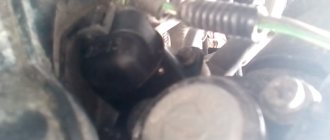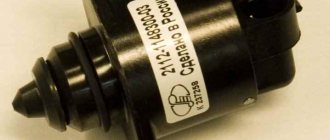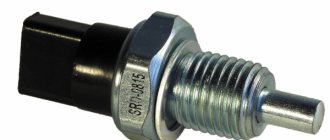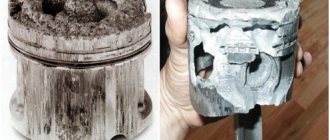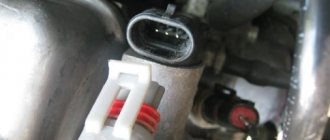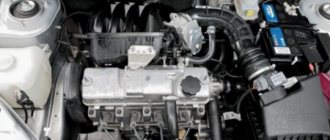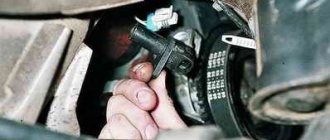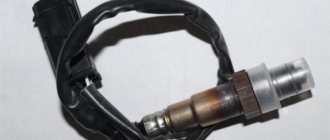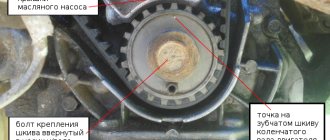Types of idle speed sensors
Today, automobile manufacturers present several types of IACs:
- Solenoid sensor. It works based on electromagnetic force. After voltage is applied to the coil, the core is hidden. The valve flap allows air to flow freely inside. Once the solenoid is turned off, the peripheral channel is blocked.
The operation of the sensor is monitored due to the dynamics of the frequency of command signals. A certain amount of air has its own frequency equivalent, which allows you to clearly regulate the operation of the IAC.
- Stepper. The technical structure of such a sensor includes a ring magnet and windings. Due to the stepwise supply of voltage to each element, under the influence of a magnetic field, the main rotor rotates. The executing mechanism, depending on the position of the rotor, controls the opening of the air duct.
- Rotary sensor. Control occurs through alternating frequency pulses. It is very similar in structure to the solenoid IAC, but the main place in the design is occupied by the rotor itself.
Purpose of the IAC regulator
The idle air regulator is used exclusively in electronic ignition systems:
- the proportions of the fuel mixture in the injector are determined by the on-board computer;
- the amount of gasoline or diesel fuel for each cylinder is measured by the ECU;
- sensors are installed in the electronic ignition
DPKV(crankshaft),
TPDZ
(throttle valve),
Mass air flow sensor
(air), DD (detonation), based on the signals of which the fuel pump is activated and the ignition is distributed to specific cylinders;
- when the gas pedal is released, the fuel damper is completely closed, the proportions of the fuel mixture are violated, combustion products are sucked back into the combustion chamber due to the pressure difference between
intakeAnd
exhaust manifold
Purpose of the IAC
Based on the results of the air sensor signals, the controller makes a decision to further enrich the fuel mixture with air, ignoring the readings of the throttle sensor at this moment.
The chip on the IAC transmits a signal from the ECU; a bypass channel opens in the idle air regulator, through which air passes in the injector or additional fuel in the diesel engine. Engine speed is leveled, piston and crankshaft wear is reduced
Purpose of the idle speed sensor
Purpose of IAC in vehicles equipped with an electronic ignition system:
- The microprocessor module determines the ratio of air and fuel when creating the air-fuel mixture in the injection power unit.
- The control unit measures a certain volume of gasoline or diesel fuel.
- The electronic type of systems is equipped with controllers for the crankshaft, throttle position, knock and flow meter. In accordance with the readings of these devices, the fuel pump is activated. The ignition is distributed to specific cylinders of the internal combustion engine.
- If the driver releases the gas pedal, the fuel valve closes completely. This leads to the fact that the proportions of the combustible mixture are violated. Combustion products move into the chamber when there is a difference in pressure between the exhaust and intake manifolds.
The idle speed sensor in electronic ignition systems performs the function of adjusting the composition of the combustible mixture during engine starting. Using the signals sent by the controller, the microprocessor module makes a decision about fuel enrichment. In doing so, it ignores the readings sent by the throttle control. The sensor transmits signals along the line. If necessary, a free channel opens in it through which air passes. This leads to equalization of engine speed while driving or idling.
User Roman Lozovoy presented a detailed review of the controller from the manufacturer General Motors for the Daewoo Lanos.
Operating principle
In carburetor engines, the problem of enriching the mixture when starting the internal combustion engine was solved by a starting handle and shims. With the advent of electronic ignition, this is done by the idle air regulator in conjunction with other sensors and the computer. Its operating principle is as follows:
- IAC calibration is performed by the ECU controller automatically after detecting this sensor in the system;
- in fact, the IAC is a stepper motor with a conical needle in a special hole in the throttle valve bypass channel;
- The IAC contact does not transmit any signals to the “brain” of the machine, but receives them from the controller, therefore it is not a sensor, but an actuator - an electric valve;
- in turn, the on-board computer “sees” that there is not enough air in the fuel mixture based on the signals from the mass air flow sensor, compared with the signals from the air flow sensor;
- Voltage is applied to the XX regulator, the needle leaves the channel, and the missing amount of air enters the mixture for mixing.
Operating principle of the IAC
In addition, the ECU receives signals about the temperature of the coolant and oil in the system. When starting in the cold season, it is necessary to warm up the engine to operating temperature in order to reduce wear on friction parts, so the IAC channel opens slightly to enrich the mixture for the injector, even without the driver pressing the gas pedal.
At the moment of start, the operating algorithm is as follows:
- the key turns, the ignition turns on;
- the rod extends all the way, the needle blocks the bypass channel;
- at the moment the rod rests against the calibration hole, the computer counts the steps backward;
- voltage is applied to the windings, the valve returns to the open position.
The number of reverse steps is programmed in the device firmware. For example, for Basch modifications on a warm internal combustion engine it is 50 steps, January – 120 steps, respectively. In total, the stroke of the rod is divided into 250 steps; the further it extends from the windings of the stepper motor, the greater the number of steps the ECU will count. When purchasing a new IAC, the distance from the mounting flange to the rod needle should be exactly 23 mm.
Signs of a malfunctioning idle speed sensor
The main problem will be that this part is not equipped with any type of self-diagnosis. On the control panel you will not see a flashing light or an inscription that will indicate a malfunction of the IAC. Everything will depend on your attentiveness and how you feel and hear your car. Signs that indicate that a part is worth checking include:
- the car began to stall at idle (uneven idle speed);
- a sharp drop or increase in speed during idle;
- when driving on a cold engine, the speed does not increase;
- When changing gear, the car stalls.
There are few reasons why the IAC failed. As they said earlier, this is a fairly reliable part, but it can still fail. There may be several reasons for the malfunction:
- The guide needle is worn.
- Broken contacts inside the part.
- The needle is clogged due to poor quality fuel.
As we all know, fuel is one of the most important components of the operation of both the engine and the car as a whole, and the idle speed sensor is no exception. Most of the reasons for part failure are the use of gasoline with impurities.
A malfunction and inadequate operation of the XX sensor is indicated by any changes in the engine speed. If the part fails completely, you will not be able to start the car without using the gas pedal. And such a procedure will negatively affect the operation of the vehicle as a whole. Manufacturers do not recommend this practice for nothing.
Replacing the idle speed sensor
The change procedure is performed as follows:
- All actions are carried out with the engine turned off.
- The controller installation location is being searched. It is necessary to unscrew two mounting screws from the installed sensor. The failed device is being dismantled.
- Installing a new regulator is carried out in the reverse order. When performing the task, you need to fix the controller in the seat and tighten the screws completely. The sensor must not be secured loosely, as exposure to vibrations during movement will cause it to break.
- During installation, it must be taken into account that the distance between the mounting flange and the controller should be no more than 2.3 cm.
- The terminal block is being connected.
- After connecting, you need to activate the ignition for 10 seconds. The power unit does not start. When the ignition is turned on, the microprocessor module calibrates the newly installed device. After ten seconds, the engine can be started and the functionality of the regulator can be checked.
User OVSYUK presented a visual guide to replacing the idle speed controller in a car.
Preventive measures
In order not to encounter a complete malfunction of the regulator in the future, it is worth periodically carrying out the cleaning process described above.
How often to carry out the cleaning process depends on how actively you use your vehicle. If the car is a work vehicle, it is recommended to check and clean the sensor once a year; if you use it only for yourself, once every two years will be enough. But, of course, do not forget about the signs of a part malfunction; if they appear, do not delay. This will help you avoid complete failure of the part and enjoy a high-quality ride. Together with you, we come to the conclusion that the part is unpretentious, simple in its functionality and use. Don’t forget: timely detection of a malfunction is the key to overall vehicle productivity. The full operation of the engine depends on the serviceability of each of its components, and if you neglect any part, including the idle speed sensor, this can lead to more labor-intensive repair processes and failure of the entire car.
Checking the idle speed sensor
Diagnosing the part is quite easy, but pay attention to a few points. The first problem may be removing the part; most manufacturers attach the XX sensor to screws, and in extreme cases they can be drilled out, but in some variations the part is mounted on varnish. If your regulator is secured with varnish, be careful not to forcefully remove it, as this may damage the intake part of the car. In your case, it would be correct to completely dismantle the throttle assembly and only then disconnect the IAC.
The easiest way to check is, of course, visual inspection. During a visual inspection, the first thing you should pay attention to is whether the needle is dirty. Also pay attention to the condition of the contacts and the throttle valve itself.
If broken wires are found, they must be returned to their place. Solder them and, to avoid corrosion, treat them with varnish.
It would be appropriate, if possible, to check the IAC with a multimeter or a homemade tester. You can check the resistance with a multimeter, and use a homemade tester (you can make one from a mobile phone charger) to check the stroke of the regulator rod.
If you find that the motor is damaged, the rod is completely worn out, or the cone needle is worn out, the part will need to be replaced. Don’t be too upset about this, the cost of the part will only be about 1000 rubles.
Method for checking the sensor using a multimeter
The most reliable and common way to check the functionality of the sensor is to use a multimeter. But to do this, the regulator must first be removed. Typically, it is secured with several screws near the throttle sensor, but on some cars it can be secured with a special solution or varnish.
It is impossible to dismantle the IAC using force, since there is a high risk of damaging the intake system. In such a case, you will have to remove the entire throttle assembly.
To check the electric motor, it is necessary to measure the resistance of the windings. The multimeter contacts must be connected in turn to each of the windings A and B, C and D. If everything works properly, the data obtained will fall in the range of 40–80 Ohms.
As an additional check with a multimeter, the contacts can be swapped. The sensor, in this case, should indicate an open circuit.
IDLE SENSOR CONTAMINATION
Often the cause of improper operation of the idle air regulator is its contamination. In such a situation, you can replace the sensor (which is inexpensive) or clean it. Cleaning the idle speed sensor takes place in two stages: You need to moisten a cotton swab with a special product (for example, which is used to clean a carburetor) and use it to clean the contacts of the sensor. This must be done carefully so as not to damage them; The remaining parts of the regulator can be cleaned mechanically using the product indicated above. Moisten a toothbrush with it, for example, and carefully clean the needle, rod, spring, removing accumulated dirt.
Reasons for failure of the idle speed sensor
The incorrect operation of the IAC can be judged by the following criteria:
- No or unstable idle speed.
- Turning off the engine while the vehicle is moving at neutral speed.
- When warming up in cold weather, the engine speed does not rise to 1500.
- Also, when you turn on electrical appliances, a drop in speed is possible, but this may also indicate a malfunction in the vehicle’s electrical network.
The most common reason for the failure of the idle speed sensor is oil from the boat exhaust system, in other words, from the breather. When this liquid gets on the sensor needle, coking occurs due to the fact that the throttle mechanism is constantly heated by the water system.
This happens quite quickly and noticeable idle problems appear more and more often, directly depending on the condition of the piston system. In some cases, if the engine is heavily worn, it is recommended to disconnect the breather from the air system and seal the inlet before repairing it. This will not only help avoid frequent cleaning of the idle air regulator, but will also help save fuel consumption, because in addition to oil particles entering the air channel, carbon dioxide escapes from the crankcase, which prevents complete combustion of the fuel.
Another common cause of rough idle is a poorly sealed air system. Most often, the auxiliary pipes on the adsorber and the fuel pressure regulator are damaged; the corrugation in the area of the mass flow sensor (mass fuel flow sensor), which is installed on the air filter cover, may burst.
These faults can only be corrected by replacement. As a rule, when the air channels are damaged, an uneven idle is observed with a characteristic hissing under the hood or when the speed is constantly raised.
If the car has covered a lot of kilometers, more than 50,000, then it is advisable to wash the entire throttle assembly, and based on the results, proceed directly to replacing the idle speed unit itself.
Cleaning the needle and bypass channel
To provide access to valve parts, removal of the IAC is required using the following technology:
- disconnecting the block from the connector;
- cleaning the connector contacts and plug with a cotton swab soaked in WD-40;
- unscrewing screws with a curved screwdriver;
- removing the regulator to check the condition.
IAC cleaning
Attention: There is no need to disassemble the regulator, just spray the spring and rod with needle with WD-40 spray, wait for it to dry, and at the same time clean the throttle bypass channel.
The adjustment is made by the on-board network controller itself. However, for stable operation of the engine, you should check the distance from the mounting flange to the protruding needle cone. By default it should be 23 mm.
Nuances of choosing an idle speed sensor
The original idle speed sensor is marked as XX-XXXXXXXX-XX. The last two digits indicate the compatibility label:
- odd (01 and 03) are interchangeable, even (02 and 04) are also interchangeable;
- These groups are not interchangeable with each other, that is, instead of the “native” 02, valve 01 or 03 cannot be used.
Even with original regulators, it wouldn’t hurt to additionally lubricate the IAC with a mixture of lithol and WD-40 (spring and rod). Since replacing IACs with your own hands is in demand among car enthusiasts, there are counterfeit regulators that can be identified by the following characteristics:
- there are no distinctive marks on the packaging;
- yellow sticker on the body without frame;
- dark needle tip;
- thin black o-ring instead of thick red seal;
- body rivets do not have heads with a diameter of 3 mm;
- a white spring instead of a black product with frequent winding;
- the body is 1 mm shorter.
An example of a counterfeit IAC
Since installation is always done on your own, additionally lubricate the rod and spring to increase the service life of the IAC and the entire engine.
Thus, it is better to have an IAC solenoid valve costing 300 - 500 rubles in stock in order to replace it in the field to normalize the idle speed of the internal combustion engine. These diagnostic methods will allow you to determine a malfunction of the regulator and a clogged bypass channel of the throttle valve.
Air flow sensor: principle of operation, types, malfunctions, photos
Fuel system check valve: functions, types, design and principle of operation
Tiptronic automatic transmission - what is it and why is it needed?
Types of malfunctions of the idle speed sensor
The most common malfunctions of the VAZ idle speed sensor are as follows:
- loss of contact or unstable contact. The main reason for this lies in the oxidation of the connector or moisture getting inside it. Often this malfunction occurs periodically, which makes diagnosis difficult;
- contamination of the rod, which significantly impedes its movement. This is usually due to untimely replacement of the air filter;
- failure of the electric rod motor. It is one of the symptoms of increased voltage in the on-board network. Or it indicates the low quality of the idle air regulator used, which is also not uncommon;
- air leakage due to destruction of the sensor o-ring;
- rod wear. In this case, the rod may become stuck in one position and move spontaneously, which negatively affects the quality of the fuel mixture.
The most typical malfunction that occurs not only on VAZ cars, but also on most modern foreign cars is contamination of the rod. The air filter traps only large dust particles, and microscopic dust particles penetrating through it are deposited over time on the throttle valve and the regulator rod. Untimely replacement of the filter, use of the so-called “nulevik” and violation of the tightness only hasten the moment of failure of the regulator.
In turbocharged engines, another cause of malfunction is turbine wear: during this breakdown, oil enters the air pipe, where it contaminates literally everything - the throttle valve, the regulator rod, the receiver itself, the air channels, etc.
One of the important points in preventing problems is regular cleaning of the damper - it will not only help prevent possible damage to the regulator, but also stabilize the operation of the engine and its response to pressing the gas pedal. It is recommended to use standard carburetor cleaner as a flushing agent.
It is important to know that when the sensor rod is critically contaminated, an increased load is created on the electric motor, which can lead to its failure. Also, on some ECU models, rather weak protection against increased consumption has been observed, which causes the resistor of the electronic control unit to burn out. Despite the relatively low cost of the resistor itself, restoring the unit is a very expensive procedure, especially since identifying this malfunction requires diagnostics using special equipment.
